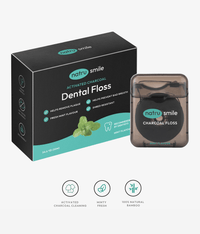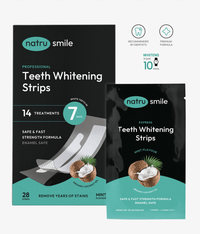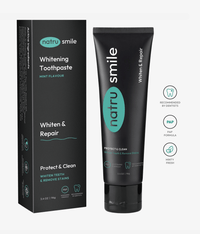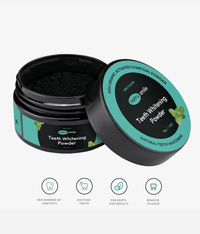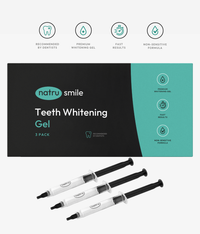
All products are certified by dental expert Dr. Greg Grillo
The quest for a perfect, picture-worthy smile has led to a myriad of dental treatment options. Among these options, veneers and crowns stand out as two popular and widely utilized dental procedures that both aim to enhance the appearance and functionality of your teeth.
In this comprehensive and detailed article, we'll break down the key differences between veneers and crowns, diving into everything from the basic concepts to crucial factors you should take into account when determining which treatment is best suited for you and your specific dental needs.
What Are Veneers And Crowns?
Before we delve into the differences between these two dental procedures, let's first clarify what each one entails.
Veneers
Veneers are thin, custom-made shells made from porcelain or composite resin materials that attach to the front surface of the tooth. They serve as a way to correct imperfections in the tooth's shape, size, veneer color, or position, essentially providing a facelift for an individual tooth or multiple teeth. Veneers are typically applied to teeth that show when you smile, offering a minimally invasive solution for cosmetic dental issues (not including snap-on veneers, which are even easier to manage)
Crowns
Crowns, on the other hand, also known as caps, are dental restorations that fully encase a tooth, providing protection and structural support. They are made from various materials, including porcelain, porcelain fused to metal, or full gold crowns. Crowns are generally used when a tooth has been significantly damaged, decayed, or has undergone root canal treatment, to preserve the remaining tooth structure and restore its shape, appearance, and functionality.
Key Differences Between Veneers And Crowns
Now that we have a basic understanding of what veneers and crowns are, let's examine some of the key aspects that set them apart.
Treatment Purpose And Goals
Veneers are primarily focused on addressing cosmetic imperfections, such as discolored, chipped, misshaped, or mildly misaligned teeth. They are an excellent option for those seeking aesthetic improvements in their smiles without the need for more extensive dental work. In a way, they’re one of the most effective teeth whitening options – if you pit other methods of teeth whitening vs veneers, veneers almost always come on top.
Crowns, however, are often employed when more substantial dental work is required. As they cover the entire tooth, they provide protection and reinforcement for a tooth that has been weakened by extensive decay, fractures, large fillings, or following root canal therapy.
Tooth Preparation And Enamel Removal
Veneers require less enamel removal than crowns due to their more conservative design. Typically, only a small portion of the enamel from the front surface of the tooth is removed to create space for the veneer. This procedure preserves more of the underlying tooth structure, making veneers a less invasive option than crowns.
Crowns necessitate the removal of more tooth structure as they encase the entire tooth. A dentist will have to trim down the tooth significantly from all sides and the top to make room for the crown, resulting in a greater loss of the patient's original tooth substance.
Longevity And Durability
Both veneers and crowns are durable restorations; however, crowns tend to be more robust due to their complete coverage of the tooth, offering additional structural support. Veneers, while strong, are more prone to chipping or cracking as they simply cover the front portion of the tooth. That said, they’re still a vital part of any teeth whitening kit.
In conclusion, the decision to choose between veneers and crowns will significantly depend on your specific dental needs, goals, and financial considerations. It's essential to consult with your dentist to identify the most appropriate treatment plan for your unique situation. Armed with the information in this in-depth guide, you will now approach the decision-making process for veneers vs. crowns with greater confidence and insight.
Veneers Vs Crowns: Overview
When it comes to selecting the right treatment option, understanding the fundamental differences between veneers and crowns is crucial.
As we talked about, a veneer is a thin shell that is typically constructed from either porcelain or composite material and is securely bonded to the front surface of a tooth. Meanwhile, a crown is a more extensive covering that entirely encases or "caps" the affected tooth. These two orthodontic treatments differ in several key respects— from the involved procedures, costs, subsequent aftercare, and even their overall aesthetic appearance (gum veneers for receding gumlines, for instance, are partially pink!).
Let's dive deeper into the finer details of veneers and crowns, comparing and contrasting them and their respective benefits and drawbacks, to help you make an informed decision when selecting a specific orthodontic treatment for your dental needs.
Veneers Vs Crowns Procedures: In-Depth Comparison
Procedure
When comparing veneers and crowns, the procedures for each differ in scope and degree of invasiveness.
The veneer procedure typically involves the dentist gently scraping off a small portion of the tooth enamel from the front surface of the tooth, making room for the veneer. This step is done to ensure a natural fit between the veneer and the remaining tooth structure. The veneer, usually made of porcelain or composite resin, is then custom-fitted and bonded to the tooth using dental cement to secure it in place. Some dentists also whiten composite veneers before or after this step.
Dental crown procedures, on the other hand, require the removal of a more substantial amount of tooth structure - usually about 1.5 to 2 mm - from all tooth surfaces. This is done to accommodate the crown, which will completely encase the tooth. After the dentist prepares the tooth, they take an impression, from which the crown is fabricated in a dental laboratory. During a subsequent visit to the dentist, the crown is cemented onto the tooth to ensure a secure, lasting fit.
Time
There are time considerations to take into account when comparing veneers and crowns.
Veneers typically require two visits to the dental office. The first appointment involves tooth preparation, taking the impression of the prepared tooth, and selecting the correct shade of the veneer material. Laboratory work may take one to two weeks, after which a second visit is needed to permanently bond the veneer to the tooth. The total time spent on veneer treatment varies depending on a variety of factors such as the number of teeth being treated and the quality of the laboratory work.
Crown procedures require two to four visits to the dental office. The initial visit typically consists of tooth preparation and taking an impression. In some cases, a temporary crown may be placed during an additional visit to protect the prepared tooth while the dental laboratory fabricates the final crown. The entire process for crowns usually takes about three to four weeks, including the time needed for lab work and the possible placement of a temporary crown.
Cost
When considering cost, veneers generally tend to be less expensive than crowns due to less invasive tooth preparation and less material used. However, the cost of either treatment varies based on a range of factors, such as the type of material utilized (e.g., porcelain or composite resin), the complexity of the case, the expertise of the dental professional, and the geographical location where the procedure is performed. In any case, both are almost certainly more expensive than at-home teeth whitening or natural teeth whitening options.
Aftercare
Both veneers and dental crowns necessitate proper oral hygiene practices and regular dental check-ups to ensure their longevity and continued functionality. While veneers need regular maintenance, crowns typically require more care in the form of frequent dentist visits, particularly to avoid causing damage to the underlying tooth structure.
Can Crowns And Veneers Be Combined? A Comprehensive Look Into Dental Restorations
It's not uncommon for individuals to wonder if crowns and veneers are able to be combined in a dental treatment plan, especially when they're looking to enhance the overall appearance and health of their teeth. In certain situations, your dentist may indeed suggest a combination of these two dental restorations to improve your smile. In this section, we'll discuss when this combination might be recommended and how it benefits the patient.
First, let's briefly recap the primary purposes of crowns and veneers. Dental crowns are typically employed to restore the strength and functionality of a tooth that has been badly damaged or decayed. They act as an aforementioned "cap" that covers the entire visible part of the tooth, improving its structure and appearance.
On the other hand, veneers focus primarily on cosmetic improvements. These thin, custom-made porcelain shells are bonded to the front surface of your teeth to enhance their shape, size, and color. Veneers are an ideal solution for people with discolored, chipped, or slightly misaligned teeth.
Now, when might a combination of crowns and veneers be recommended? In cases where a patient requires both a functional restoration and aesthetic improvement, using a combination of dental crowns and veneers effectively addresses these concerns. For instance, veneers are utilized to enhance the appearance of the front teeth, while crowns provide the necessary support and protection to the badly damaged or decayed teeth in other areas of the mouth.
The major benefit of combining crowns and veneers is that patients achieve a more harmonious and comprehensive dental restoration, meeting their functional and cosmetic needs simultaneously. In consultation with your dentist, a personalized treatment plan is created to determine the most suitable combination of crowns and veneers for your specific situation.
How To Understand Which One Is Right For You? A Comparison
Deciding between veneers and crowns is tricky, as the best choice will largely depend on your specific dental situation and your dentist's professional recommendations. Both treatment options have their own set of advantages and drawbacks, and understanding these differences will be crucial in ensuring you make the correct choice for your unique oral health needs. Generally, veneers are better suited for minor cosmetic fixes, while crowns are a more appropriate solution for addressing severe tooth damage or decay.
In-depth Comparison Of The Costs, Aesthetics, & Fit
A Closer Look At The Costs And Insurance Considerations
Dental insurance may contribute towards covering the cost of crowns and veneers; however, it's crucial to scrutinize your policy for specifics regarding coverage. Some insurance plans may solely cover treatments necessary for functional reasons, rather than those implemented purely for cosmetic purposes. Additionally, different policies may have varying limits on the amount they pay out for dental work, so it's essential to understand your financial responsibility when considering these treatment options.
Evaluating Their Aesthetics
One significant factor that influences people's choices between crowns and veneers is their appearance. Veneers are often the preferred choice due to their natural-looking results. Owing to their thinness, veneers successfully imitate the way light reflects off and passes through natural teeth, creating a seamless blend with the adjacent teeth. Crowns, conversely, exhibit differences in appearance depending on the material from which they are made. However, modern all-porcelain crowns also bear an uncanny resemblance to natural teeth, offering patients a lifelike appearance.
Assessing The Fit And Functionality
When it comes to how crowns and veneers fit and function, there are some crucial distinctions to consider. As veneers only cover the front surface of a tooth, they don't provide the same level of structural support that crowns offer. Crowns fully encapsulate the tooth, making them a more suitable option for repairing severely damaged or decayed teeth, whereas veneers offer a more conservative solution for minor cosmetic alterations, such as discolored or slightly misshapen teeth.
The choice between a crown and a veneer depends on various factors, such as the extent of the damage to your tooth, aesthetic preferences, financial considerations, and individual oral health needs. It's essential to consult with your dentist to help determine the best course of action for your specific situation. They will evaluate your teeth and discuss your goals, offering personalized advice to ensure the best possible outcome.
Questions To Ask Your Dentist
Is There Any Special Care To Apply?
Once you've received a veneer or crown, it's essential to care for them properly to ensure their longevity. Your dentist will likely recommend that you maintain good oral hygiene by brushing and flossing regularly, as well as avoiding chewing on hard objects such as ice or candies that could damage your restoration. Don't hesitate to discuss your dental care routine with your dentist and inquire about any specific precautions or products you should use to take care of your veneer or crown.
Will I Need To Wear A Mouth Guard?
Depending on your circumstances, the dentist may recommend wearing a mouth guard, particularly if you suffer from bruxism (teeth grinding) or engage in contact sports that could present a risk to your dental work. A custom-fitted mouth guard helps protect not only your veneer or crown but also your natural teeth, reducing the risk of injury or damage. Make sure to ask your dentist if a mouth guard is necessary for your situation and if you should consider wearing one during certain activities.
How Long Do You Expect My Veneer Or Crown Material To Last?
Veneers and crowns are quite durable, lasting for many years if properly cared for. However, the specific lifespan of your veneer or crown largely depends on the chosen material, as well as how well you maintain your oral health and the restoration itself.
Make sure to discuss the expected longevity of your chosen treatment with your dentist and understand what factors could potentially impact its lifespan. Knowing this information will help you make informed decisions about your dental care and enable you to take the necessary steps to prolong the life of your veneer or crown.
Now that you know what questions to ask your dentist, here are some more questions you may have with answers that will help you make an informed choice.
Which Lasts Longer: Veneers Or Crowns?
The lifespan of both veneers and crowns depends on various factors such as the material used, oral hygiene, and the patient's habits, including their diet and whether they grind their teeth at night. While both options last for several years, crowns generally have a longer lifespan than veneers. On average, crowns may last anywhere from 10 to 20 years or more, while veneers last between 5 to 15 years, with proper care.
Do Crowns Look As Natural As Veneers?
While traditional crowns, such as metallic or porcelain-fused-to-metal crowns, may not look as natural as dental veneers, modern all-porcelain or all-ceramic crowns closely resemble the appearance of natural teeth. Advances in dental technology have allowed for significant improvements in the aesthetics of crowns, making it possible to achieve a more natural-looking restoration.
Are Crowns Stronger Than Veneers?
Yes, crowns offer more structural support since they cover the entire tooth. They are typically stronger and more durable compared to veneers, making them a better solution for severely damaged or weakened teeth. Veneers, on the other hand, are a more conservative and aesthetically-driven treatment option primarily intended for minor imperfections and minor damage.


